Step by step treatment procedure is here.
Many people have been able to take pictures of their infested fishes and sent them to me. Some I have received are presented here to help others understand what they are facing. The pictures below were not taken by me but others. Please respect their privacy. Their words follow the pictures.
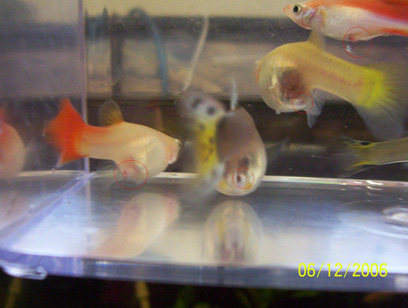
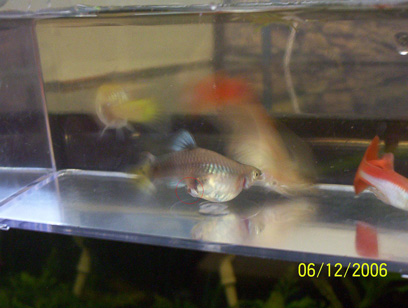
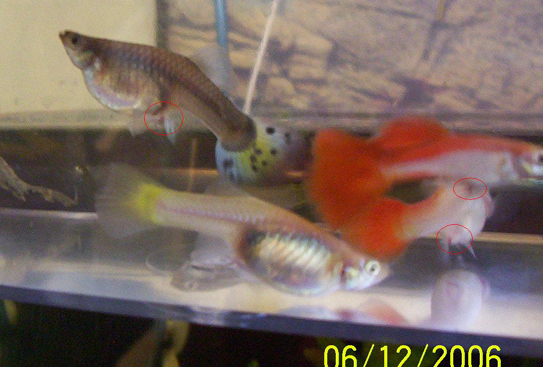
| December 6 - 12, 2006 |
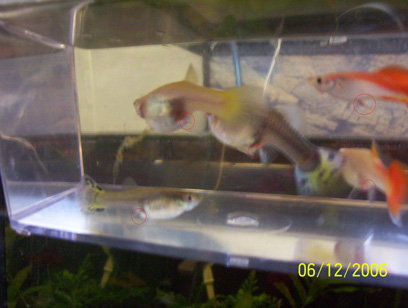 |
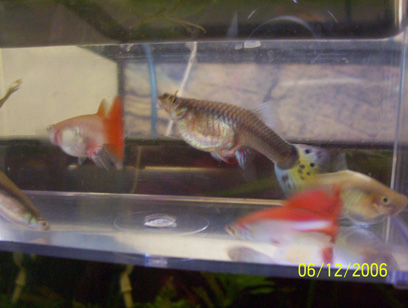 |
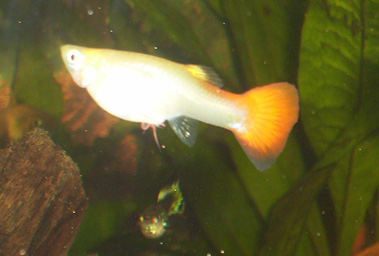 Start treating Start treating |
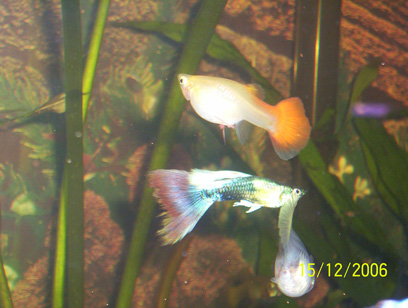 |
 |
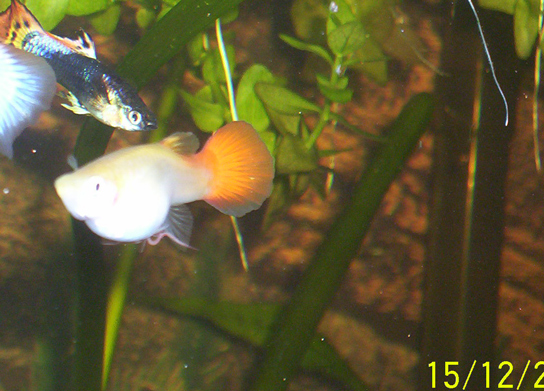 |
Internal devastation from the Camallanus Nematode. 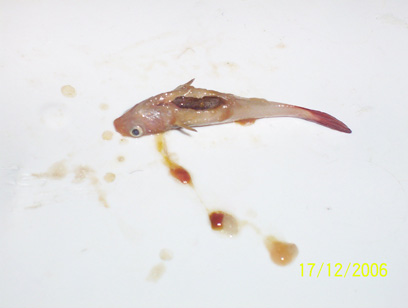 |
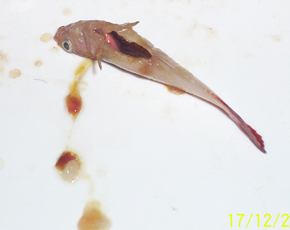 Seven out of 10 guppies survived. A second treatment insured no more Nematodes. |
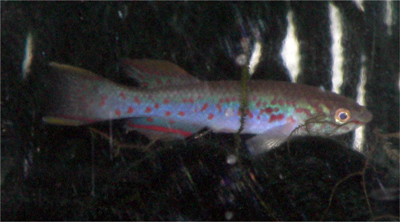 |
| The Nematode is not always easy to spot. But once one does, the Female Nematode is dumping live young into the tank water to infest the other tank members. |
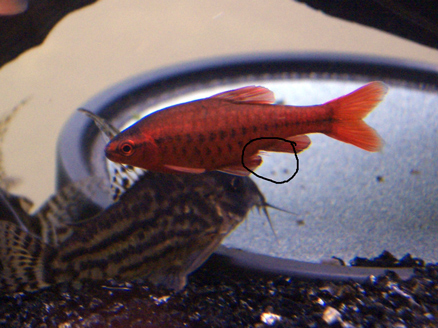 |
 |
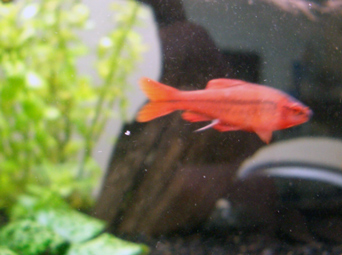 |
 Sometimes only after treatment is the Nematode (then dead) visible. |
| BACK |
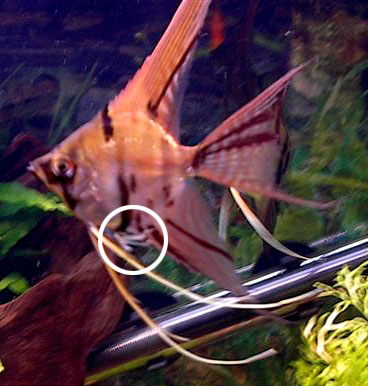 |
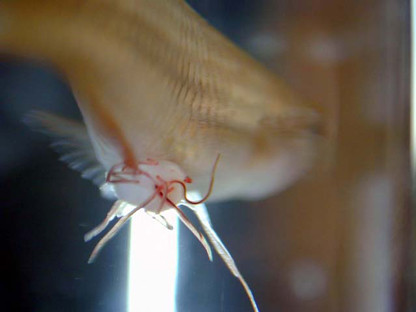 |
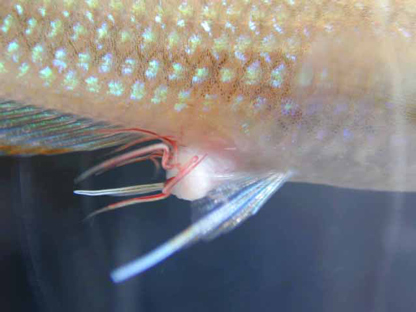 |
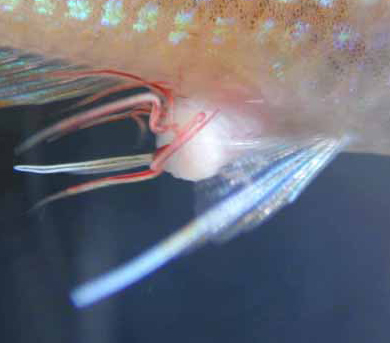 |
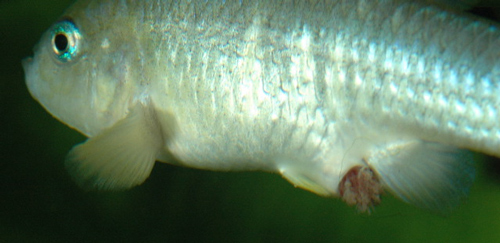 |
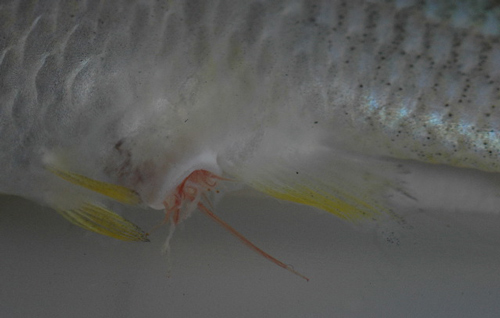 |
| I will save some more space for others to fill in as we discover more. Remember, some will survive, and some, well . . . the size of the fish is really important. |
| BACK |
Some questions and answers follow --->>
We have been offering the Nematode treatment since 1996. There have been literally 100's of people who have found these parasites in their fish and have emailed me for help. This site is linked to by various forms and email lists as well as articles on the web. Still, there remain questions about how to treat the Nematode and what to do about massive water changes, etc. One such group of questions comes from a housewife living in Maryland. She writes:
" I have had my guppies for a while now. I get them all from the same fish store. About 3 weeks after I bought snails from a pet store I started to notice what looked like baby guppy tails hanging out of my very pregnant females. I waited a day and watched and then noticed there were more, it looked more like a hermit crab coming out of their hole and then it would suddenly disappear. Then a few days later I noticed my males had it too. I freaked, disgusting!!! I called all the fish stores i got the fish from and was faced with sacarasm. I researched on the internet and right away found plenty.
I first tried 'Clout', which was recommended by a fish store, it did nothing- I repeated the treatment 3 times and nothing again.
I then went and bought 'Anti-Parasite medicated fish foods it's for internal parasites and says it treats Camallanus. Tried for 3 days and the worms were hanging lower, but visibly alive and moving. During all this I have about 25 week old baby guppies in the same tank that haven't been affected /harmed by any of the treatments.
I then found something recommended over the internet for treatment of Camallanus "Parasite Clear- Praziquantel", nothing
again!!! Very Frustrating. Please remember all the friggin water changes and hassle of all this, I have a broken foot, 3 kids, other pets, along with a demanding two year old- this is very inconvenient- everyone says 'flush them' but I can't.
I then found a different website which said Levisole Bolluses work, even though they leave a mess. Well, the first day I used 1/50 of a bollus as recommended by their calculator, some worms did seem to be gone, but I then was noticing a lot hanging out of ones that didn't show any before, they were still moving too. I then found a different site that said to use... I'm trying to remember, I think it was 3 bolluses for a ten gallon tank. Well, like I read before, WHAT A MESS! I believe I was supposed to wait 48 hours but after 24 I had a major bloom of some kind than was very thick through out the whole tank, it even filled the tubing for the filter and it could barely work to move the water. The gravel- EVERYTHING was covered. at this point the friggin snails that I blame died. My fish were under distress and laying on the gravel (not the babies, they seem unaffected) so I quickly did a 100% water change, had to scrub everything, it was coated with an inch of slime and replaced the carbon filter and am feeding them brine shrimp right now hoping that they might pass the still visible worms, some look dead, some look alive but I am going to have to give them a break to get healthy again or I am sure they will die.
Why on earth is this so impossible??
I have ordered the Levamisole powder and am grateful it's available, out of all the reading it is very unclear to me how many days in a row to treat, do I change the water every 24 hours and retreat for 3 straight days, do I treat once and leave it for 3 days? Do I remove or leave in place the carbon filter, do I leave the light off or continue it normal?? Do I treat one day a week for 3 weeks or treat once and again in three weeks or WHAT!!!? I have removed all the gravel and plants so the worms have no where to hide and I'm sick of cleaning it, is this a bad idea cause the fish will eat their dead worms or does it not matter?? Every one has frigggin different ideas- I just want my fish to be better already. HELP!!!!!!!!"
and, it sounds like a lot of other people who have been frustrated with the Nematode.
I first started working on the problem in 1996. I found sources for the different de-worming compounds and different companies to purchase them from. I found there was only one substance which worked every time, Levamisole Hydrochloride. That's about a dozen years of working with these parasites.
The lethal dose for treatment has been determined from studies with cattle. The weight of a steer or calf and the weight of water in aquariums were equated so I could weigh out the dosages for different amounts of water. I targeted 10 to 15 ppm as a standard dosage. That is 5 grams in 100 gallons of water(13.5 ppm). So I add 10 tablespoons of water in a glass and mix in the powder. Now each tablespoon of the solution will treat 10 gallons.
It takes about 36 hours to kill the adult Nematodes, less time to kill the smaller ones. The compound paralyzes the worm and this kills it. The eggs inside the large adult female worms don't die apparently from this dosage. So the adult worm dies and falls to the bottom of the tank to spill out the eggs days later. These hatch and produce infectious young in a few days. That is why the second treatment. It takes about 2 weeks for the small worms to get started again. So, treat a second time in 3 weeks.
The medication needs to remain in the water for 3 days (2 nights) No carbon filter, it takes the medication out. pH doesn't make any differences in the treatment. Light doesn't affect the drug at this level unless there is a UV sterilizer in the system. Undergravel filters are ok. Everything that stays wet needs to be treated to get rid of the Nematode and the residence time is at least 48 hours. 3 days is best. The drug can be dosed at twice the amount without harm to the fish. The dead Nematode is much more deadly to the host. The smaller the host the more the problems they have expelling the dead worms, large fish don't have near the problems.
That adds a lot of corrections to the questionable information around.
If after reading this you still need more information send me an email to: charles@inkmkr.com
As a Post Script to the first entry above, the lady wrote back:
"
Wow, It really worked well. No visible worms and very small bellies!! During the treatment all of the adults layed on the bottom of the tank and the babies were unaffected, I was afraid I was going to lose the adults- they were breathing hard too- but after the full water change this morning , they all look very healthy and happy. During this my one guppy gave birth to 9 deformed babies so I guess that's what medicine can do. And my bottom feeders took it rough- one died and the other looks like he won't make it. I am so worried about buying anymore fish from anyone else with the fear they may be carrying who knows what with them. I am so glad you had that medicine available or they all would've been true goners.
Thank you! I really appreciate it. "
Others have had the following to write:
Hello Randy,
Thank you for the thoughts and notes. Perhaps I can add a little more information.
Dissolve the 5 grams of medication in a known amount of water. An 8 ounce bottle of drinking water would be good. You know there is 8 ounces there. Now, half of that, 4 ounces, will treat 50 gallons of water. 2 ounces will treat 25 gallons. When you have done your treatment, mark the bottle with a permanent marker as to what is in it, cap it tight and put it in the refrigerator. It will keep for 3 months there but I would throw it out after 2. You might tape the cap closed just to keep others from trying to drink it. It is not really harmful but not intended for human consumption. It taste terrible! Very bitter and tends to cling to the palette. Two treatments are necessary because of developing eggs inside the large female Nematodes. These worms can be killed and expelled while the eggs continue to develop inside the protection of the dead adult. If they aren't removed and it is hard to get everything there may be several living larva of the Nematode hatching out in the tank. A second treatment helps to prevent this from spreading.
The role of the Levamisole is to paralyze the Nematode and thus to kill it. The fish then needs to pass the dead worms. The Levamisole in the tank will kill all the stages of the Nematode as long as it is there in sufficient quantity. It takes only 36 hours to kill 99% of the worms both inside and free in the tank. The remaining living Nematodes can re-infect everything very soon given the opportunity.
Once you have managed to really do in the infestation, it is time to flush the septic tank. I don't mean a 20% water change twice a week. That reaches an equilibrium with the tank trash and really never gets rid of everything.
In the treatment I try to get the owner to understand that after the treatment is done they need to change ALL of the water. This removes the dead Nematodes, the dead other things and helps to reestablish good living conditions within the tank environment. One does not kill the bacteria and protozoa attached to the plants, walls and gravel with a water change. I wouldn't advocate a complete tank cleaning because there will be a recycling time and the fish keeper is putting the fish through a lot of stress.
Change the water, all of it and then lets see what is left of the strange visitors in the tank.
The dead worms in the gut of the fish are the greatest cause of loss of fish after treatment. I am watching a young man now in CA with a Cichlid tank struggling with this. The Nematodes are dead but the fish are really having a hard time of it. Their guts are full of dead clinging things and they are rotting inside the fish. Bacteria, septicemia, gas bloating - all the nastiest one can think of. Feeding the fish lots of live foods will generally move the stuff through the gut. Newly hatched brine shrimp is my best remedy for these small fishes.
Hope this helps.
~~~~~~~~~~~~~~~~~~~~~~~~~~~~~~~~~~~~~~BACK
Hello Gail ,
The Camallanus Nematode is a really vicious parasite! I have had request after request for help and have been able to save a lot of fish, but the parasite grows so fast and multiplies so fast that it kills the fish before the aquarists has the opportunity to do anything.
Normally, neither the plants or fish are affected by the medication. The death of the worms however can kill the fish. So very often the water changes do in the fish as well.
I can send Priority Mail to anywhere in the USA for $3.85 ( $4.80 now(Feb 2008)) and express mail for $13.85. Moot point this late Friday PM. But, let me know what you want to do and where you want the meds sent.
One 5 gram packet of Levamisole treats 100 gallons of water. Lower the water level and treat more fish. You will probably need to treat twice to completely remove the parasites.
My first suggestion is to change their water completely, 100% or close to it. If they survive that you are on your way to saving the fish. After treatment it is best to change 75 to 80% of their water and after the second treatment best to change all of their water again. This will take about 3 to 4 weeks for the total process.
Getting rid of these things is not easy and lots of fish have been lost both to the parasite and the water changes. Placing the medication in tank water with healthy fish and plants for two to 3 weeks doesn't seem to do anything but kill the snails.
Let me know where and how to send the meds and what you want to do. I will see if I can follow through . . .
Charles Harrison
~~~~~~~~~~~~~~~~~~~~~~~~~~~~~~~~~~~~~~
Hello again ,
ok I just want to make sure I really get this right... If i do the recommended water changes before and after each dose of treatment it will kill the nematodes in my fish and flush them out of the tank. And treatment won't affect my plants... But can the worms live in a host other than fish and snails??? They can't live on a piece of wood, can they??? I'm asking because all of my branches have plants growing on them...
I'm very curious to know about the stages of life of a Camallanus worm... How long do they usually live? Also how long would I have to wait before declaring my tank worm free??? What are the chances of the worm coming back? As i've mentioned before this is my second encounter with this parasite and I'm afraid that this time around i've sold fish that may have been contaminated... What would you recommend? I've notified all those who have bought from me and so far nothing has come up but we 're all worry about cross contamination...
Ah I was going to forget... When is it considered "to late" for a fish? I've sacrificed several silvertips that looked sick and my apistos have it as well. The only difference between the two is that the apistos show no signs of infection except the little bit of worm coming out their anus... They are still eating and reproducing . ...( If a female has fry , what are the chances of them being infected???)
Any suggestions will be greatly appreciated... :)
Thanks again
~~~~~~~~~~~~~~~~~~~~~~~~~~~~~~ BACK
Hey Charles,
I'm thinking I might need to retreat. I've lost two more swords and another guppy. I have another sword not eating and eliminating that funky-clear ribbon. On the paper, it seemed to read to wait a 3-4 weeks. But, should I wait?
I have done a roughly 70% water change with an aggressive vacuum of the gravel. I was concerned that vacuuming stirred up something as one of the swords looked like she was getting some body slime and others started "bouncing" off the gravel. So, I've been treating with Melafix and Paraguard.
I was thinking to do another water change (50%?) and then retreat with the Levamisole? I've also contemplated a sterilization of the entire tank. Any advice would be most appreciated as it's really wearing on me to see these guys keep going down.
Thanks much.
Regards,
Bob
Hi Charles,
Just wanted to give you a follow-up to my ordeal. Per your recommendation, I've held off on the adult tank and I'm still holding off. The remaining fish appear to be very healthy, energetic, and happy (whew!). I did lose a couple more a few days after our last communication, but I'm pretty sure they were the result of infestation and the following infections that you spoke of. I still may retreat, JUST to be safe.
In my fry/juvenile tank, I did end up retreating. I could definitely see that some of them were still infected. I retreated, left the Levamisole in for two days, and that looks to have cleared the buggers out. I didn't lose anymore of them, which was great to see.
Hopefully, I've seen the end of these rotten things. I'm not fooling myself though.
Just so you know, I had no snails in either tank, so this was either a fish-to-fish, gravel-to-fish, or water-to-fish transfer? I do have a decent amount of gravel. I now understand this isn't such a good thing and may be where the larvae were able to live? These rotten things infected every type of fish in the tank; swords, mollies, platies, and guppies. The effects were very visible on the female guppies; really tearing a hole in the vent area. But we couldn't understand what we were seeing. We were actually thinking some sort of fish vd... The swords didn't show any external damage and the disection of one was what allowed me/us to finally figure out what was going on. Once I knew what to look for, I saw that one platy had one tear out of it's stomach area, and we could see the worms in the female guppies. Funny thing is, I have this female sword that a neighbor gave us as a juvie since almost the beginning of the tank. She's been a voracious eater, picking at ANYTHING even remotely looking like food in the tank, and never became infected that I could see.
Anyway, I can't thank you enough for the assistance. It was really wearing on my family and me to be constantly losing our fish. We can now, finally, get to the enjoyment part of the hobby and we're now on guard with what to look for.
I've made our local fish store aware of the problem and they are now are guard.
Feel free to use my name or experience as you see fit.
Many thanks and best regards,
Bob